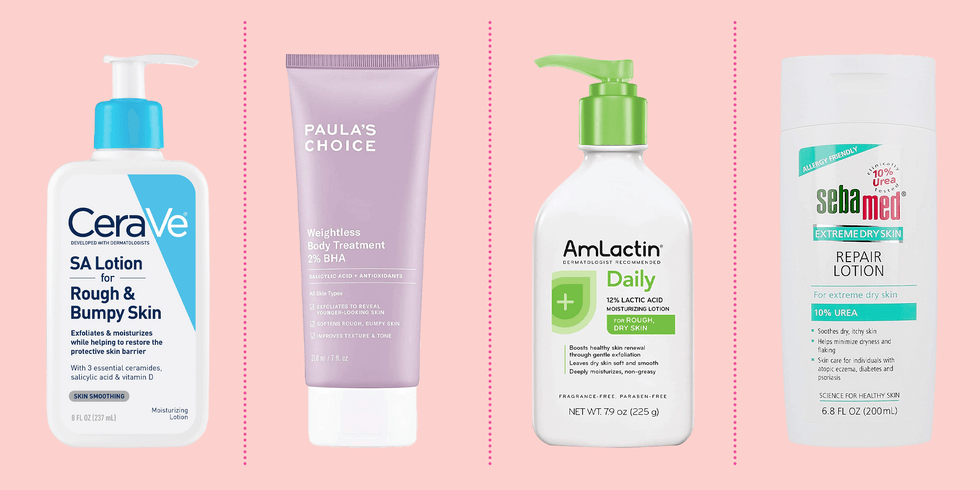Read Full Article Here13 Best Treatments for Keratosis Pilaris, According to Dermatologists
You know how your skin can get all goosebumpy when you watch a Jordan Peele movie, or you go out in the first chill of autumn wearing a short-sleeved tee? Well, for some people, those bumps are a constant presence, and they have nothing to do with being spooked or cold. Keratosis pilaris, or KP, is a harmless but annoying condition in which the skin on your arms, thighs, face or butt can feel scaly, dry and bumpy.
“Often referred to as chicken skin, KP does indeed have that pebbly, slightly gritty texture to touch,” explains Mona A. Gohara, MD, an associate clinical professor of dermatology at Yale School of Medicine. Dr. Gohara explains that KP is mostly due to genetics — thanks, Mom and Dad! But you’re in good company: “KP affects 40 to 80% of the general population at some time in their life, and it affects all races and ages,” says Stephen Matlock, MD, a dermatologist with U.S. Dermatology Partners in Joplin, MO.
The condition crops up often among adolescents, with up to 80% experiencing the skin bumps — many simply outgrow it by the time they become adults. While the bumps don’t hurt or itch, and they don’t require any treatment, they can definitely be annoying when you want your skin to look its smoothest in shorts or a tank top. The best way to treat KP is with topical creams designed to break down the keratin spikes, says Dr. Gohara, who recommends products that include alpha hydroxy acids (AHAs) such as lactic acid, glycolic acid or urea. “Depending on your budget, there are dozens of over-the-counter creams and medicated creams that work well,” says Dr. Matlock.
1 BEST OVERALL BODY LOTION TO TREAT KERATOSIS PILARIS
Daily Moisturizing Body Lotion – AMLACTIN
2 BEST VALUE BODY LOTION TO TREAT KERATOSIS PILARIS
Ammonium Lactate Lotion – PERRIGO
3 BEST BODY CREAM FOR KERATOSIS PILARIS ON AMAZON
Moisturizing Skin Cream with Pump Dispenser – VANICREAM
4 BEST KERATOSIS PILARIS TREATMENT FOR FACE
Down to Tone
5 BEST EXFOLIATING BODY LOTION TO TREAT KERATOSIS PILARIS
SA Lotion for Rough & Bumpy Skin – CERAVE
6 BEST BODY TREATMENT FOR KERATOSIS PILARIS ON AMAZON
Weightless Body Treatment – PAULA’S CHOICE
7 BEST BODY SCRUB TO TREAT KERATOSIS PILARIS
KP Bump Eraser Body Scrub – FIRST AID BEAUTY
8 BEST GLYCOLIC ACID LOTION TO TREAT KERATOSIS PILARIS
Skin Smoothing Body Lotion – REVERSA
9 BEST VALUE GLYCOLIC ACID LOTION TO TREAT KERATOSIS PILARIS
T.L.C. Glycolic Body Lotion – DRUNK ELEPHANT
10 BEST UREA-BASED BODY LOTION TO TREAT KERATOSIS PILARIS
Extreme Dry Skin Repair Advance Therapy Lotion – SEBAMED
While it’s always best to check with your dermatologist before treating any skin conditions, here are 12 products that the experts we spoke to — and online reviewers with KP — say really work.
“Though they can be harder to find, urea-based formulas can be quite effective,” says Dr. Yadav. Urea helps skin stay soft by trapping moisture from the environment and bringing it into the skin. This German-made brand with 10% urea gets top reviews on Amazon.
11 BEST CLEANSING/MOISTURIZING SET TO TREAT KERATOSIS PILARIS
GLYTONE – KP Kit
Dr. Gohara recommends this duo, which includes an exfoliating body wash to slough off dead skin cells and a soothing body lotion, both with glycolic acid. “The glycolic acid breaks down the keratin spikes that cause the bumps,” she explains. It even comes with a shower pouf.
12 BEST AHA CREAM FOR KERATOSIS PILARIS
SKINFIX – Resurface+ AHA Renewing Body Cream
Dr. Matlock reports that many of his patients are fans of this cream. The vegan formulation includes 5% natural AHA to smooth out bumpy skin. “AMAZING! I’ve been using this for a few years now, and it’s been life changing!! The only thing that works on my KP and keeps my skin smooth all winter,” a Sephora reviewer said.
13 BEST BAR SOAP FOR KERATOSIS PILARIS
CETAPHIL – Gentle Cleansing Bar
If you prefer to wash with a bar soap, Dr. Matlock recommends this moisturizing cleansing bar from Cetaphil, which is as gentle on your skin as it is on your budget. It is tested for sensitive skin and claims to remove bacteria and germs without clogging pores, making it a good bet for those with KP. On Amazon, it has over 10,000 5-star reviews.
How we chose the best treatments for KP
We consulted a panel of dermatologists who gave specific recommendations based on their expertise. Treatments that weren’t explicitly recommended had specific ingredients that those doctors suggested. Others had high online ratings from people with KP.
What exactly is keratosis pilaris?
Those little bumps of yours are caused by the buildup of the protein keratin, which plugs up the hair follicles, creating the little spikes of skin — it tends to be worse in people with dry skin. “Keratosis pilaris is commonly seen in people who have eczema or other conditions that make their skin prone to dryness,” says Dr. Yadav. “The skin can feel rough or scaly in the affected areas, and the bumps are usually skin-colored.” She adds that the condition can get worse in the winter, since cold weather and low humidity dry out the skin. “Anything that can irritate or dry the skin has the potential to worsen KP,” adds Dr. Matlock. “This includes things like harsh, drying soaps, fragrances, detergents, aggressive exfoliation, and hot water—including hot showers.”
Is salicylic acid or lactic acid better for keratosis pilaris?
Salicylic acid, lactic acid and alpha hydroxy acids (AHAs) are all ingredients in keratolytics, also known as chemical exfoliators—these are used to remove the buildup of dead skin. All three can be effective in softening up the keratin plugs that cause the bumps on your skin. “Make sure you’re not too harsh or forceful on your skin when you use these,” says Dr. Yadav.
How do I get rid of keratosis pilaris permanently?
Keeping up a regular routine of cleansing, exfoliating and moisturizing with products specifically designed to tread KP is your best bet, but it won’t happen overnight. “Remember this is a genetic condition! Although we can do things to make it look better, it is in your DNA, so don’t get frustrated,” says Dr. Gohara. “Generally, this naturally gets better and less noticeable with time.” If you are really concerned with your KP, talk to your dermatologist, who may suggest retinoids, topical steroids or anti-inflammatories, or even laser treatments.
Why trust Good Housekeeping?
As senior editor in the Hearst Health Newsroom, Marisa Cohen spends her days doing deep dives into health and wellness topics, covering every topic from head to toe (literally). She has spent more than 20 years interviewing top experts in their fields, reading through medical journals, and navigating information from reliable online sources to bring trustworthy advice to readers. In addition to writing for Good Housekeeping and Prevention, she has previously contributed health features to Self, Real Simple, Fitness, Health, WebMD, and Fit Pregnancy, among other magazines and websites.
13 Best Treatments for Keratosis Pilaris, According to Dermatologists
December 8, 2022








